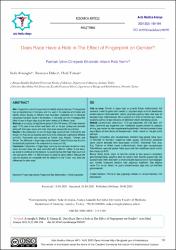Does race have a role in the effect of fingerprint on gender?
Abstract
Aim: Fingerprint is one of the personal and reliable physical features. The fingerprint
has an important role in forensics, and it is used in the detection of criminals and
identity checks. Studies on different races have been conducted, but no interracial
comparison has been found in the literature. In this study, we have investigated the
effect of race on finger ridge using the same method on 5 different races.
Methods: In our study, the right thumb prints of 355 (148 female, 207 male) students
aged 17-25 years in our school were taken with an ink pad (stamp) and recorded
along with their ages, sexes, and races. Data were analysed by sex and race.
Results: In the comparison by sex, the finger ridge counts of male (11.94±2.08) and
female (12.76±2.02) participants were found to be statistically significantly different
(p<0.001). Participants were classified as Turkish, Arab, Russian, Turkmen, and
African. The difference in finger ridge counts between Turkish-Africans was found to
be statistically significant in the comparison by races (p<0.05).
Conclusion: Comparison of finger ridge counts by sex has been studied on many
races, but each study has been conducted with a different method. In our study,
we aimed to contribute to the literature by examining how the finger ridge counts of
men and women differ in 5 different races by using the same method. Although the
data we obtained are compatible with the literature for the Turkish race, there are
differences for other races.
Source
Acta Medica AlanyaVolume
5Issue
2URI
https://dergipark.org.tr/tr/download/article-file/1925842https://hdl.handle.net/20.500.12868/1717


















